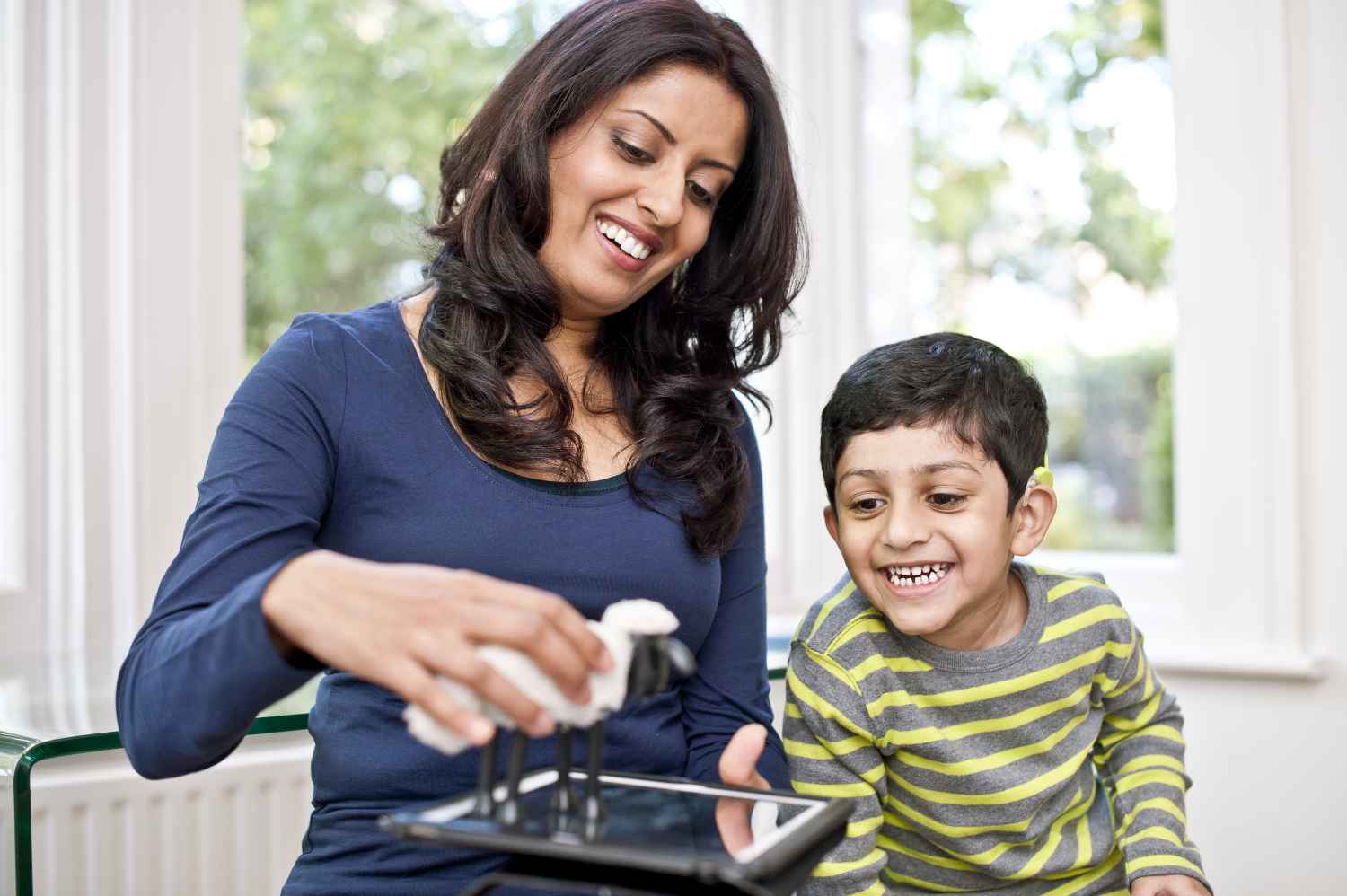
MaryKay Therres
Published Jan 01, 2016
3 Free Cochlear Implant Rehabilitation Activities for Any Child
Learn about three free cochlear implant rehabilitation activities to help your child improve their speaking skills. Tailor these activities to their hearing age and individual needs, and explore essential strategies like expanding, extending, and highlighting. Ensure that your child has the right support every step of the way.

Make sure your child does the cochlear implant rehabilitation activities that are appropriate for their age. Here’s how.
A child will start developing their speaking skills in three pretty predictable stages:
- Using sounds or trying to imitate words
- Using single words
- Using multiple words tied together
Each child will develop these at different speeds. Not everyone who’s had a cochlear implant for one year or five years will have the same skills. That’s why the best kind of cochlear implant rehabilitation activities are the ones tailored to the recipient’s hearing age and individual need, instead of a program that claims it’s designed for a child of X years old. This is what MED-EL’s rehabilitation is all about: we don’t believe in the one-size-fits-all strategy, so our resources are made to be mixed and matched so that they can fit your child perfectly.
Different Strategies to Help Your Child
Rehabilitation activities are built around different communication techniques. These techniques are like building blocks, and you can use a single technique or combine them together.
Below is some practical information about rehabilitation and some easy, useful, different activities for different hearing ages.
Expanding
Repeat what your child said to you ensuring that it’s grammatically correct. You’re not adding any new information, just using the ideas your child said in a correct sentence.
For example, if they say the grammatically incorrect sentence “I like to eat grapes, they good,” you could expand this by saying “I like to eat grapes because they are good”. Expanding this will help your child to hear immediately how they should structure their words in a grammatically correct way.
Extending
Extending means adding in new information. When you respond to your child, add a few words that are related to what they have said, so that he or she can grow their vocabulary, and learn how to combine more words together in their sentences.
For example, if your child says “The baby crying,” you could say “The baby is crying because she is hungry.” Extending the sentence tells your child why the baby is crying: it brings in new information.
Highlighting
Highlighting is emphasizing a specific sound or word to draw attention to it.
For example, if your child says “Daddy eating,” you can say “Daddy is eating.” You can highlight a word by increasing the volume of your voice or by lengthening the word, when you say it.
Pause and Wait
Don’t immediately repeat your question to your child, or answer it yourself. Allow and encourage your child to start speaking by staying quiet and looking at them expectantly, waiting for them to respond.
Want to learn more strategies? Check out these 6 additional strategies we put together!
3 Specific Cochlear Implant Rehabilitation Activities
Here are three different activities that can bring these strategies to life. Again, choose the right one for your child’s hearing age. Once you feel they can do that activity, then you can move on to the next one.
Children Just Starting to Speak
These activities are for someone who’s just learning how to use their voice. All you need is a ball.
- Start by rolling a ball back and forth.
- Say “go” each time your child rolls the ball, and encourage them to say “go” when you’re ready to roll it to them.
- Use the pause and wait strategy by looking at your child expectantly, and wait for them to say something before rolling the ball back.
- When your child has started putting words together, add a player to the game. Use short statements to mention a person and what you want to do.
- For example, as you hold the ball roll it to the third player and say “daddy catch the ball.” Roll the ball to daddy and have him catch it.
- Then, he’ll say “child’s name catch the ball” and roll the ball to your child.
- Your child can then choose which parent to talk to, and what they should do (throw, roll, bounce, catch, tap…). When your child is first putting words together, they won’t use all the words in a sentence. They might start with “mommy throw” and then with time start using connecting words.
- With time, start introducing prepositions through a hide-and-seek game.
- Put a box in the middle of the room, and then hide the ball somewhere.
- Tell your child where it is by using a simple sentence with a preposition (“The ball is under the chair.” “The ball is on the couch.”).
- Once your child finds the ball, let them try to make a basket in the box.
- Then let your child hide the ball and tell you where it is. If they say “The ball is behind the car,” repeat it back to them and emphasize ‘yes! It’s behind the car.’
A Child Who Can Connect Words
These activities are for someone who’s started connecting words. You can do them by just taking a walk.
- Start by walking around a park or neighborhood.
- Point out the different things you see.
- As you point something out, tell your child: “I see a bird,” “I see a tree,” “I see a dog.” Keep using that starter phrase, “I see a…”
- Encourage your child to point out things using the same phrase.
- When your child is comfortable identifying things, start describing them.
- As you’re pointing something out, describe it: “I see a red bird,” “I see tree that looks old,” “I see a big, black dog.”
- Encourage your child to use descriptive words when pointing things out.
- Extend and expand what your child said, so that they can hear some new words and correct grammatical structures which they could use in their own statements.
- Use more complex sentences.
- Use more complex sentences to describe what’s happening: “The dog that is across the street is sleeping,” “The car parked behind the tree is green,” “The woman wearing a black jacket looks cold.”
- Encourage your child to use these sentences by extending and expanding.
Using Complex Sentences
Once your child can start connecting words and use complex sentences, you can do more advanced activities. These ones can be done while getting dressed.
- Lay out all your child’s clothes and let them choose what they want to wear.
- Review their names and have your child tell you what they want: “Socks, shoes, shirts, pants…” “I want those socks,” “I want the shirt…”
- Pause and wait for your child to speak to you, instead of just grabbing the clothes article.
- Encourage your child to use descriptive words in a sentence.
- This is like the one above, just that you’re encouraging your child to be more descriptive.
- Let your child to pick out the clothes by saying “I want the orange and blue shirt,” “I want my black pants,” “I want the striped socks.”
- Start using past, present, and future tenses.
- Ask your child questions or make comments that have to do with time: “What will you wear today?” “What are you wearing now?” “That’s the shirt that you wore ”
- Encourage your child to use sentences that have to do with time.
- Future: As your child is picking out specific clothes, have them say words like “I will wear my yellow shirt today,” or “I will wear my tennis shoes today.”
- Present: Once your child has gotten dressed, ask them to describe what they are wearing: “I am wearing my yellow shirt now,” or “I am wearing my tennis shoes now.”
- Past: Have them put away their clothes from the day before, and ask them what they wore: “I wore my red shirt yesterday,” or “I wore my boots yesterday.”
Activities like these are ones that should come up normally through the day. You don’t need to set aside a specific period of time as Rehabilitation Time. When your child is enthusiastic about what they’re doing day to day, they’re way more likely to learn from it.
References

MaryKay Therres
MaryKay Therres (MSc., CCC-SLP, LSLS Cert. AVT, AST Therapist) is a Speech-Language Pathologist who has over 30 years of experience working with individuals who use hearing technology. She is the Senior Manager of Education and Rehabilitation for MED-EL Headquarters.
Was this article helpful?
Thanks for your feedback.
Sign up for newsletter below for more.
Thanks for your feedback.
Please leave your message below.
Thanks for your message. We will reply as soon as possible.
Send us a message
Field is required
John Doe
Field is required
name@mail.com
Field is required
What do you think?
© MED-EL Medical Electronics. All rights reserved. The content on this website is for general informational purposes only and should not be taken as medical advice. Contact your doctor or hearing specialist to learn what type of hearing solution suits your specific needs. Not all products, features, or indications are approved in all countries.

MaryKay Therres
MaryKay Therres (MSc., CCC-SLP, LSLS Cert. AVT, AST Therapist) is a Speech-Language Pathologist who has over 30 years of experience working with individuals who use hearing technology. She is the Senior Manager of Education and Rehabilitation for MED-EL Headquarters.

MaryKay Therres
MaryKay Therres (MSc., CCC-SLP, LSLS Cert. AVT, AST Therapist) is a Speech-Language Pathologist who has over 30 years of experience working with individuals who use hearing technology. She is the Senior Manager of Education and Rehabilitation for MED-EL Headquarters.


